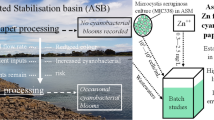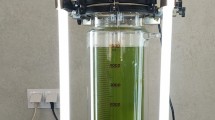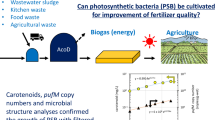Abstract
An investigation was made into the physiological characteristics of the extensive cyanobacterial communities in pulp and paper secondary waste-treatment systems, including the capacity of isolates to biodegrade organic contaminants in these systems. Although pulp and paper waste-treatment systems were found to be severely light-limited, photosynthesis-irradiance curves indicated that shade-adapted cyanobacterial communities could fix conspicuous amounts of inorganic carbon via photosynthesis. Of 21 cyanobacterial strains isolated from pulp and paper waste-treatment systems located in 4 countries, all except one were capable of glucose uptake in the light, and 19 also showed uptake in the dark. In the 6 species tested, glucose and acetate addition stimulated growth in low light in all except one species. Aphanocapsa rivularis grew equally well on glucose and acetate in the dark but Pseudanabaena sp. grew well on acetate, and minimally on glucose. Growth stimulation by glucose and acetate in these two strains was greater in low than in high light. Pseudanabaena sp. and Phormidium animale both accumulated 2,4-dichlorophenol and 3-chlorobenzoate but showed minimal mineralization to CO2. None of the four species tested could accumulate or degrade phenol or dichloroacetate. It is concluded that, depending on the light conditions, cyanobacteria contribute organic carbon in photosynthesis, and/or remove small organic molecules during mixotrophic and heterotrophic growth but are not important degraders of contaminants in these waste treatment systems.
Similar content being viewed by others
References
Allen M.M. 1968. Simple conditions for the growth of unicellular blue-green algae on plates. J. Phycol. 4: 1-4.
American Water Works Association 1995. Standard Methods for the Examination of Water and Wastewater. 19th edn., Denver, Colorado, USA.
Bagchi S.N., Chauhan V.S. and Palod A. 1990. Heterotrophy and nitrate metabolism in a cyanobacterium Phormidium uncinatum. Current Microbiol. 21: 53-58.
Beardall J. and Morris I. 1976. The concept of light intensity adaptation in marine phytoplankton: some experiments with Phaedoactylum tricornutum. Mar. Biol. 37: 377-387.
Bryant C.W., Barkley W.A., Garrett M.R. and Gardner D.F. 1997. Biological nitrification of kraft wastewater. Wat. Sci. Tech. 35: 147-153.
Chapman D.J. 1973. Biliproteins and bile pigments. In: Carr N.G. and Whitton B. (eds), The Biology of Blue-Green Algae. Bot. Monogr. 9. University of California Press, Berkely, USA, pp. 675.
Currie D.J. and Kalff J. 1984. A comparison of the abilities of freshwater algae and bacteria to acquire and retain phosphorus. Limnol. Oceanogr. 29: 298-310.
Currie D.J. 1990. Large-scale variability and interactions among phytoplankton, bacterioplankton and phosphorus. Limnol. Oceanogr. 35: 1437-1455.
Falkowski P.G. 1984. Physiological responses of phytoplankton to natural light regimes. J. Plankton Res. 6: 295-307.
Fogg G.E., Stewart W.D.P., Fay P. and Walsby A.E. 1973. The Blue-Green Algae. Chap. 9. 161-179. Academic Press, London & New York, 459 pp.
Fulthorpe R.R. and Allen D.G. 1995. A comparison of organochlorine removal from bleached kraft pulp and paper-mill effluents by dehalogenating Pseudomonas, Anclyobacter and Methylobacterium strains. Appl. Microbiol. Biotechnol. 42: 782-789.
Gapes D.J., Frost N.M., Clark T.A., Dare P.H., Hunter R.G. and Slade A.H. 1999. Nitrogen fixation in the treatment of pulp and paper wastewaters. Wat. Sci. Tech. 40: 85-92.
Gauthier F., Neufeld J.D., Driscoll B.T. and Archibald F.S. 2000. Coliform bacteria and nitrogen fixation in pulp and paper mill effluent treatment systems. Appl. environ. Microbiol. 66: 5155- 5160.
Hansman E. 1973. Chap. 23, 359-368. Pigment analysis. In: Stein Janet R. (ed.), Handbook of Phycological Methods. Culture Methods and Growth Measurements. Cambridge University Press, 448 pp.
Harris G.P., Haffner G.D. and Piccinin B.B. 1980. Physical variability of phytoplankton communities II. Primary productivity by phytoplankton in a physically variable environment. Arch. Hydrobiol. 88: 303-327.
Hausalo T. 1995. Analysis of wood and pulp carbohydrates by anion exchange chromatography with pulsed amperometric detection. Proc. 8th International Symposium on Wood and Pulping Chemistry (ISWPC), Helsinki, Finland 3: 131-136.
Jansson M. 1993. Uptake, exchange, and excretion of orthophosphate in phosphate-starved Scenedesmus quadricauda and Pseudomonas K7. Limnol. Oceanogr. 38: 1162-1178.
Jarvinen R. 1997. Nitrogen in the effluent of the pulp and paper industry. Wat. Sci. Tech. 35: 139-145.
Khoja T.M. and Whitton B.A. 1971. Heterotrophic growth of bluegreen algae. Arch. Mikrobiol. 79: 280-282.
Kirkwood A.E., Nalewajko C. and Fulthorpe R.R. 2001. The occurrence of cyanobacteria in pulp and paper waste-treatment systems. Can. J. Microbiol. 47: 761-766.
Kuritz T. and Wolk C.P. 1995. Use of filamentous cyanobacteria for biodegradation of organic pollutants. Appl. environ. Microbiol. 61: 234-238.
Lean D.R.S. and Nalewajko C. 1979. Phosphorus turnover time and phosphorus demand in large and small lakes. Arch. Hydrobiol. 13: 120-132.
Liss S.N., Bicho P.A. and Saddler J.N. 1997. Microbiology and biodegradation of resin acids in pulp mill effluents: a minireview. Can. J. Microbiol. 75: 599-611.
Liukko S. and Poppius L.K. 1999. Characteristics of dissolved organic material in total chlorine free bleach plant and laboratory effluents. Wat. Sci. Tech. 40: 249-258.
Marquez F.J., Sasaki K., Kakizoo T., Nishio N. and Nagai S. 1993. Growth characteristics of Spirulina platensis in mixotrophic and heterotropic conditions. J. Ferment. Bioeng. 76: 408-410.
Narro M.L. 1987. Petroleum toxicity and the oxidation of aromatic hydrocarbons. In: Fay P. and Baalen C.V. (eds), The Cyanobacteria. Elsevier Science, pp. 493-511.
Narro M.L., Cerniglia C.E., Van Baalen C. and Gibson D.T. 1992. Metabolism of phenanthrene by the marine cyanobacterium Agmenellum quadruplicatum PR-6. Appl. environ. Microbiol. 58: 1351-1359.
Nikkila A., Paulsson M., Almgren K., Blanck H. and Kukkonen J.V.K. 2001. Atrazine uptake, elimination and bioconcentration by periphyton communities and Daphnia magna: effects of dissolved organic carbon. Environ. Toxicol. Chem. 20: 1003-1011.
Paerl H.W., Bebout M.S., Joye B. and Des Marais J. 1993. Microscale characterization of dissolved organic matter production and uptake in marine microbial mat communities. Limnol. Oceanogr. 38: 1150-1161.
Pinckney J., Paerl H.W. and Fitzpatrick M. 1995. Impacts of seasonality and nutrients on microbial mat community structure and function. Mar. Ecol. Progr. Ser. 123: 207-216.
Puhakka J.A., Maikinen P.M., Lundin M. and Ferguson J.F. 1994. Aerobic and anaerobic biotransformations and treatment of chlorinated pulp bleach waste constituents. Wat. Sci. Tech. 29: 73-80.
Radwan S.S. and Al-Hasan R.H. 2000. Oil Pollution and cyanobacteria. Chap. 11. In: Whitton B.A. and Potts M. (eds), The Ecology of Cyanobacteria. Kluwer Academic Publishers, The Netherlands, pp. 307-319.
Reuter J.E., Loeb S.L. and Goldman C.R. 1986. Inorganic nitrogen uptake by epilithic periphyton in a nitrogen deficient lake. Limnol. Oceanogr. 31: 149-160.
Rippka R. 1972. Photoheterotrophy and chemoheterotrophy among unicellular blue-green algae. Arch. Mikrobiol. 87: 93-98.
Sahu J. and Adhikary S.P. 1982. Heterotrophic growth and pigment composition of four filamentous blue-green algae. Arch. Hydrobiol. Suppl. 63: 189-199.
Schmidt T.S.K., Simkins S. and Alexander M. 1985. Models for the kinetics of biodegradation of organic compounds not supporting growth. Appl. environ. Microbiol. 50: 323-331.
Shashirekha S., Uma L. and Subramanian G. 1997. Phenol degradation by the marine cyanobacterium Phormidium valderianum BDU 30501. J. indust. Microbiol. Biotech. 19: 130-133.
Stewart W.D.P. 1964. The effect of available nitrate and ammonium-nitrogen on the growth of two nitrogen-fixing blue-green algae. J. exp. Bot. 15: 138-145.
Twiss M.R., Granier L., Lafrance P. and Campbell P.G.C. 1999. Bioaccumulation of 2,2',5,5'-tetrachlorobiphenyl and pyrene by picoplankton (Synechococcus leopoliensis, Cyanophyceae): Influence of variable humic acid concentrations and pH. Environ. Toxicol. Chem. 18: 2063-2069.
Vollenweider R.A. 1969. A manual on methods for measuring primary productivity in aquatic environments. IBP Handbook No. 12. Blackwell Scientific, UK.
Wall D. and Briand F. 1979. Response of lake phytoplankton communities to in situ manipulations of light intensity and colour. J. Plankton Res. 1: 103-111.
Wetzel R.G. 1983. Limnology. 2nd edn. Sanders College Publishing, New York, USA, pp. 767.
Author information
Authors and Affiliations
Rights and permissions
About this article
Cite this article
Kirkwood, A., Nalewajko, C. & Fulthorpe, R. Physiological characteristics of cyanobacteria in pulp and paper waste-treatment systems. Journal of Applied Phycology 15, 325–335 (2003). https://doi.org/10.1023/A:1025181116714
Issue Date:
DOI: https://doi.org/10.1023/A:1025181116714




